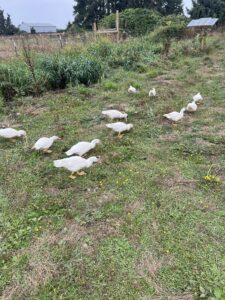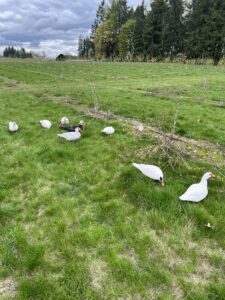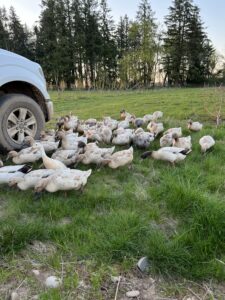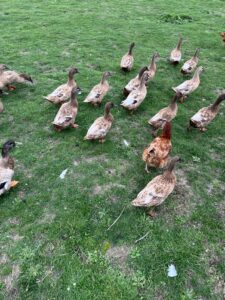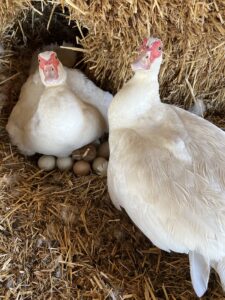Final report for FW22-391
Project Information
Pests like slugs, snails, insects, and even rodents are a big issue for orchard producers and require big costs to manage. Historically, many cultures have used ducks to reduce pests. However, this is not a commonly used practice in the United States. By using ducks against weeds, slugs, and snails, pests can be used as feed. This reduces chemical and labor costs while increasing profit with the sale of duck and eggs.
Our project combines three different breeds; Muscovy, Khaki Campbell, and Indian Runner. Areas of the orchard have been sectioned and include areas with ducks as biocontrol and control areas managed conventionally. Costs and returns will be measured for each treatment to evaluate economic and environmental sustainability. Sustainability is a must in these modern times with the immediate threat of climate change. This research will help farmers provide quality food to local communities while reducing fossil fuel use, labor and chemical costs, pollution of soil and water, and their impact on the environment.
This project is in cooperation with Oregon State University's Small Farms Program and includes technical advice and outreach capabilities. The proposed outreach plan includes an Extension article, two on-farm tours, and a presentation at a small farm workshop. Additionally, we plan to create video content and infographics to disseminate the information through multiple farmer networks and channels.
The objectives for this proposed study include:
- Examine the effectiveness of ducks as weed and pest control in an orchard crop system.
- Assess the economic and environmental sustainability of using ducks as biocontrol within an orchard crop system.
- Identify the number of ducks per acre that can control pests to the desired level while maintaining the lowest input cost.
Western SARE Farmer/Rancher Project Timeline
Project name: Effects of using ducks as biological control to manage weeds and pests within an orchard crop system
Farmer/Rancher Project #: FW22-391
PI: Peng Sun
2022
May
- Consultation completed for further developing study design with OSU Small Farms Program Faculty
- *** See Letter of Commitment from Dr. Garry Stephenson
- Began to build fences around the designated duck area
July
- 600 ducklings purchased from the hatchery, Metzer Farms (300 Muscovy, 175 Khaki Campbell, and 125 Runner)
- 64 Muscovy ducklings purchased from local farmers
- Completed the installation of a 4,120 feet fence and a 30'X96' shed
- Purchased feed, and water materials from Wilco farm store
- Created a 50'X200' pond for the ducks
August
- Released ducklings into the research area, and kept them in a shed overnight for safety against predators
- Observation: The ducklings prefer to eat pests and weeds in this order: slugs, bugs, weed seeds, then weeds
November
- Clipped duckling wings to prevent ducks from flying outside the research area
*= The original project proposal included data collection in August, October, and December of 2022, and in February 2023. After the project began and the P. I started to raise the ducklings, they weren't old enough to be eating enough weeds during the summer period and then in the fall it was outside the growing season for Oregon, so the weeds were minimal. Data collection will begin in April and will be consistent for the rest of the project timeline.
2023
February
- Reassessed fence, mobile shed, feed, and water materials
- Fix and replace as needed
- Observation: During the winter, ducks eat everything green on the field (not including the orchard or vineyard plants). We had to supply them with more grain due to a shortage of weeds. Compared to last winter before the study, almost no vole paths are visible at this time through grasses in the duck area. This may be due to the ducks eating the weeds and seeds, reducing food availability for voles.
March
- Put 40 days old ducklings into the research area
April
- Collect data for weeds/pest control
- Hayley White will create educational and promotional content (videos and an article)
June
- Collect data for weeds/pest control
August
- Collect data for weeds/pest control
October
- Collect data for weeds/pest control
December
- Collect data for weeds/pest control
2024
February
- Collect data for weeds/pest control
- Get ducklings from a hatchery or hatch ducklings
- Reassess fence, mobile shed, feed, and water materials
- Fix and replace as needed
March
- Put 40 days old ducklings into the research area
April
- Collect data for weeds/pest control
- Hayley White will create educational and promotional content (flyers, graphics, videos)
May
- Host two farm tours one open to all farmers and a second tailored to Asian American farmers
June
- Collect data for weeds/pest control
September
- Peng sun and Hayley White will present research findings and teach an educational session about the project at the regional Small Farms School held at Clackamas Community College.
- Once data has been analyzed, another article will be written and shared with OSU and Small Farm Networks.
Cooperators
- - Technical Advisor (Educator and Researcher)
- - Producer
Research
- Examined the effectiveness of ducks as weed and pest control in an orchard crop system.
For this objective, we divided the orchard into two sections across the landscape, including a control area (no ducks) and an area with ducks. Every other month, data was collected to count the number of pests. Within each section, we randomly tossed 5, 1 square foot sampling squares out and clipped vegetation. Originally we also wanted to collect numbers of slugs and snails, recent rodent holes, and weed conditions. But in this scenario, slugs, snails, and rodents were hard to evaluate using the squares. The best method for the farmer was to evaluate the presence of those pests by observing the damage to the plants that would have been typically caused by slugs, snails, and rodents in previous years. Additionally, in an orchard or vineyard scenario, traditional weed species and tall grass are both considered weeds as usually the areas require mowing. So that is why all of the squares were clipped and weighed instead of a visual count of weeds versus grass species. These measurements were taken every other month for the duration of the study.
Materials:
- Ducklings
- Fencing for containing ducks in desired areas
- 1 square foot sampling frame for counting pests and weeds
- Supplemental feed for ducks
- Portable feeders and water vessels
- Microsoft Excel to record and analyze data
- Assessed the economic and environmental sustainability of using ducks as biocontrol within an orchard crop system.
To assess the economic variables, we had a 4-acre block without any ducks and treated it as it had been conventionally managed. This included regular mowing, pest baits, herbicides, and the cost of labor calculated for the 4 acres. We calculated the costs of using ducks on 4 acres of the orchard. This included fencing, feed, labor, ducklings, and any other costs that arose within the non-control area. We evaluated if any damage was done to the orchard crops by the ducks; so far, we hadn’t seen any. The income brought in from the sale of ducks and duck eggs was deducted from the total.
Materials:
- Herbicide
- Pesticide
- Diesel for the mower
- Identified the number of ducks per acre that could control pests to the desired level while keeping the animals healthy and maintaining the lowest input cost.
We wanted to determine a balanced stocking rate of ducks per acre. Our goal was maximum weed and pest control with minimum grain input while maintaining animal health and adequate growth. This might have needed to be adjusted a few times before we found the right number, and this changed depending on the season. We tried 30, 50, and 100 ducks per acre at first and compared weed and pest control and grain input from each group for each duck per day.
| Weeds gathered in a 1-square-foot area | ||
| Control area ( no ducks) | Field with ducks | |
| Mar-23 | 33g | 0g |
| Apr-23 | 69g | 0g |
| May-23 | 135g | 29g |
| Jun-23 | 207g | 68g |
| Jul-23 | 318g | 54g |
Economic Outcomes:
Before this experiment, we sprayed Rely 280 herbicide on the rows three times per year and mowed between rows three times per year, with a total cost of $3,613, including labor, fuel, and materials. Now, with the ducks, we don't spray the rows and only mow once instead of three times, that cost is $424 saving approximately $3,189.
We sold 275 ducks at $25 each, totaling $6,875. The cost of the ducklings was $875, and feed costs were $2,160. Additionally, we sold 195 dozen duck eggs at $7 per dozen, totaling $1,365. If we don't count our time spent, the profit is $5,205. Including the money saved on weed control, the total profit amounts to $8,394.
Research Outcomes





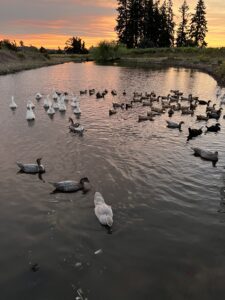
Recommendations based on our observations:
- Provide plenty of water (more than you think): Ducks require access to water for drinking and bathing. Consider providing a small pond or water trough within their contained area.
- Feed the ducks appropriately: Ducks require a balanced diet to remain healthy. Provide them with appropriate feed and consider supplementing their diet with low-grade fruits or vegetables from your orchard. If ducks do not get enough nutrition, their legs and feet can become weak or twisted, leading to limping and other development issues. Provide additional feed for the ducks during the winter, particularly for the Muscovy drakes.
- Compared to breeds developed for egg production, Muscovy ducks can fly, it is better to cut some feathers short to control them on the field. Egg-laying ducks require more feed and consume fewer weeds compared to Muscovy ducks, making them less ideal due to the higher feed costs.
- Ducks are natural predators of voles and can help reduce their populations by consuming them as shown through observations in this study so far. In addition, ducks might also help control the insects and other invertebrates that voles feed on, which can further limit their population growth. Ducks may help control voles by consuming vegetation, limiting the food supply and shelter for voles.
- In 2022, we grafted 950 sweet cherry trees, but only 57 survived (6%) due to slugs despite using slug bait. In 2023, with ducks in the field and no slug bait used, we grafted the failed 893 trees, and 879 succeeded (98%).
- Historically at this site, bacterial canker in the orchard has been a problem, and repeated hydrogen peroxide treatment is required. In 2023, one application was applied in early spring but no other applications have been required since.
- Ducks are controlling weeds so far without damage to the fruit trees or drip tubes. Compared to observations outside the duck research area, geese eat a little bit of the young apple tree bark and sheep have caused minor damage to the lower branches of fruit trees.
- The optimal number of ducks per acre depends on the season. From late February to July, we need at least 100 ducks per acre for effective weed control. However, from October to February, it's better to keep a smaller number of ducks to ensure they have enough food.
- Hatch Muscovy duck eggs in January to control weeds in the spring. Sell most of the ducks in the summer when weed growth decreases in Oregon. Keep a small number of drakes and hens for winter slug and weed control, as well as for breeding purposes.
- Muscovy drakes require more feed, and attention and tend to be weaker, but they sell for more due to their larger size.
Challenges:
- Muscovy ducklings are very fragile during shipping. 102 of 300 ducklings died in transport from the California hatchery company to Oregon. Additional ducklings were purchased from local farms, of those ducklings, 62 of 64 have survived and are growing well. Farmers may be more successful if purchasing from a local farm with less transport distance compared to a commercial hatchery.
- Muscovy ducks face several predators in our area, including coyotes, hawks (especially targeting ducklings), eagles, raccoons, and domestic dogs. Using guard dogs like Great Pyrenees can be an effective way to protect them.
- Timing hatching with the growing season and when the weeds and pests are available can be tricky. The goal would be to have ducklings ready from March to July during the growing season. A potential solution would be to use lights in the duck building to alter the hatching season.
- It was not easy to measure the amount of slugs in the data squares. The slugs aren't usually out when trying to collect samples and could not find them, but could see damage in the non-duck areas caused by slugs. A better method perhaps would be to use the evidence of the cherry tree propagation success this year in the duck area compared to previous years.
- Originally, the plan was to estimate the percentage of weeds in the data collection square, but clipping all the plants in the square proved more useful. The grass is also a non-desirable plant in the orchard, so it was treated like a weed.
- The weeds that the ducks did not consume were tansy ragwort and Himalayan blackberry. These weeds would have to be spot-sprayed or managed by sheep and goats in the future.
Benefits:
- Less slugs and slug damage observed
- Less weed pressure and shorter grass in the orchard and vineyard
- Eliminated the need to mow during the growing season
- Less rodent damage
- $5205 in additional farm income
- Saved $3189 in herbicide and mowing costs
- Less farmer exposure to herbicide
Education and Outreach
Participation Summary:
The outreach methods used to share about the project so far have been through social media like Instagram and Facebook, newsletters through OSU Extension and our partner organizations, and individual teaching contacts.
Two farm tours demonstrating the project were hosted inviting local producers interested in orchards, vineyard systems, and using ducks as pest control. These were hosted on March 23rd and 30th by Peng Sun. Outreach was through his local farmer contacts, word of mouth, and facebook groups.
An additional farm tour, partnering with the OSU Extension Small Farms Program, is scheduled for October 19th. Outreach is through OSU Extension and other regional and state-wide agriculture service providers like the Marion Soil and Water Conservation District. Using newsletters, social media, and email blasts.
An article featuring the project will be published in the regional Cultivating (printed publication) for the Fall Edition (September)
The article will also be shared in the following news publications (Mid-Willamette Valley Small Farms (regional), Marion County Extension Newsletter (county-based), and Oregon Small Farm News (Statewide).
On March 9th, 2023, Hayley White posted a picture to the OSU Mid-Willamette Valley Small Farms Facebook and Instagram pages and introduced the project briefly.
- According to Facebook analytics, the photo reached 812 people and it was shared by the Capital Ag Press, a regional agricultural news outlet
- According to Instagram analytics, the post reached 464 accounts (including 4 comments and 4 shares)
The farm hosted a tour for local farmers on March 23, 2024, with 47 farmers participating. A family farm in Hillsborough, Oregon, introduced Muscovy ducks to their operations. Additionally, a commercial sweet cherry orchard in Hood River showed interest in using Muscovy ducks for their organic fields.
On March 30th 2024, the farm hosted a tour for Asian American farmers, with 24 Asian American farmers from Oregon and Washington state participating. Four family farms introduced Muscovy ducks to their operations.
Education and Outreach Outcomes
- Utilize agriculture service providers and share outreach materials with them to be featured in their newsletters, email blasts, and social media
- Use engaging pictures and highlight that it is a farmer-led project
- A big success in this scenario was that the farmer leading this project is very involved in local farmer networks and they also meet many people through their farm business. The outreach was very successful because the farmer was talking about the project with others and inviting people to learn more
- Partnering and inviting organizations like OSU Extension, Soil and Water Conservation Districts, Friends of Family Farmers, and others is helpful when spreading the word for outreach. Cooperating with others increased the visibility of the project.
- Having the farmer also lead their own outreach (if they are interested) greatly helped with approachability, especially to groups that might not typically be a part of the traditional outreach groups of agricultural service providers.
- Farmers appreciate learning and communicating with other farmers.
- Casual farm tours without strict schedules are the most successful.
